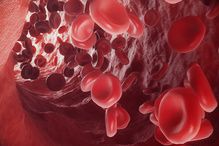Itolizumab Shows Rapid Activity in Acute Graft-Versus-Host Disease
Association between itolizumab serum concentrations and clinical response have been identified in patients with acute graft-versus-host disease treated in the phase 1b EQUATE study.

In the phase 1b EQUATE trial (NCT03763318), itolizumab, a first-in-class antibody therapeutic, decreased levels of cell-surface CD6 and increased soluble CD6 (sCD6) in serum in patients with acute graft-vs-host disease (aGVHD), according to data presented at the 2022 Transplantation & Cellular Therapy Meetings.1
Across 3 dose levels of 0.4 mg/kg, 0.8 mg/kg, and 1.6 mg/kg of itolizumab, surface CD6 levels on T cells rapidly decreased, and surface CD6 levels remained below baseline throughout treatment (P < .001). Furthermore, levels of sCD6 in serum increased as cell surface CD6 decreased, indicating that itolizumab induced the release of cell-surface CD6.
“The observed association between itolizumab serum concentrations and clinical response highlights the importance of achieving high concentrations early in the treatment period to maximize pharmacodynamic effects and clinical efficacy,” lead study author, Cherie T. Ng, senior director of research at Equillium, Inc., wrote in the poster presentation.
CD6 is a co-stimulatory receptor expressed on CD4 and CD8 T-effector cells, which control T-cell activity and trafficking.2 Additionally, the CD6 ligand, activated leukocyte cell adhesion molecule (ALCAM), is expressed on antigen-presenting cells and tissues. Both CD6 and ALCAM are overexpressed during gastrointestinal inflammation, and prior clinical studies have pointed to CD6 relevant target for the pathogenesis of aGVHD.3
Itolizumab targets the CD6-ALCAM pathway by binding to domain-1 of CD6. This causes CD6 shedding and the production of CD6low T cells. Compared with CD6high T cells, CD6low T cells are hyporesponsive to stimulation, and they exhibit decreased activation, proliferation, and cytokine production.
Data presented at the Transplantation & Cellular Therapy Meetings were from 23 patients with grade III or IV aGVHD who were enrolled on EQUATE and had pharmacokinetic and pharmacodynamic data available as of September 2021. Moreover, patients were required to receive an allogeneic hematopoietic stem cell transplant (ASCT) using myeloablative or non-myeloablative conditioning regimens and to have a clinical diagnosis of aGVHD requiring systemic immune suppressive therapy.4
Patients were excluded from the trial if they had the presence of morphologic relapsed primary malignancy, were treated for relapse after ASCT was performed, or required rapid immunosuppressive treatment withdrawal for early malignancy relapse. Other exclusion criteria included evidence of graft failure based on cytopenia, evidence of post-transplant lymphoproliferative disease, or any prior therapy for aGVHD, except for ASCT prophylaxis regimens or systemically administered corticosteroids.
All patients initiated intravenous (IV) steroids within 7 days prior to the first dose of IV itolizumab, which administered at doses of 0.4 mg/kg (n = 4), 0.8 mg/kg (n = 10), or 1.6 mg/kg (n = 9) every 2 weeks. Notably, all patients on the trial received at least 1 dose of itolizumab, while 70% of patients (n= 16) received at least 2 doses.
To determine cell surface CD6 levels on T cells, flow cytometry on fresh whole blood was performed, and a custom electrochemiluminescent assay was used to measure sCD6.
Additionally, ST2 and REG3α were quantified by ELISA, and the Mount Sinai Acute GVHD International Consortium (MAGIC) algorithm was used to calculate the MAGIC algorithm probability (MAP) score.
The primary end points of the trial were to assess the safety and tolerability of itolizumab and determine the optimal IV dose level. Secondary end points included the characterization of the pharmacokinetics and pharmacodynamics of itolizumab, and to assess the drug’s clinical activity by overall response rate, non-relapse mortality, chronic GVHD, and durability.
Additional data showed that by day 15 following the first dose, itolizumab doses of 0.8 mg/kg and 1.6 mg/kg increased the ratio of T-regulatory cells to T-effector cells. Furthermore, a decrease in PD-1 expression on T-effector cells was observed at all 3 dose levels at day 15.
Notably, 94% of patients who achieved a clinical response did so following the first dose of itolizumab. Therefore, investigators examined the relationship between itolizumab concentrations and efficacy at day 15. Higher concentrations of itolizumab corresponded to higher rates of complete responses (CRs).
At baseline, 8 patients had low MAP scores (no more than 0.290), vs 10 patients with high MAP scores (greater than 0.290). At day 15, patients who had low MAP scores at baseline achieved a CR rate of 67%, compared with 50% in patients with high MAP scores. Notably, these trends did not result in a statistical significance, possibly because of the small population size.
The results from EQUTE informed the doses that will be evaluated in the phase 3 EQUATOR trial (NCT05263999), which will evaluate itolizumab vs placebo in combination with corticosteroids as a first-line treatment in patients with aGVHD.
References
1. Ng CT, Chinn L, Acevedo LM, et al. Itolizumab, a novel targeted anti-CD6 therapy, induces cleavage of cell surface CD6 and rapid onset of efficacy in subjects with newly diagnosed acute graft-versus-host disease. Presented at: the 2022 Transplantation & Cellular Therapy Meetings; Salt Lake City, UT; April 23-26, 2022. Abstract 371.
2. Consuegra-Fernandez M, Lin F, Fox DA, Lozano F. Clinical and experimental evidence for targeting CD6 in immune-based disorders. Autoimmun Rev. 2018;17(5):493-503. doi:10.1016/j.autrev.2017.12.004
3. Soiffer RJ, Murray C, Mauch P, et al. Prevention of graft-versus-host disease by selective depletion of CD6-positive T lymphocytes from donor bone marrow. J Clin Oncol. 1992;10(7):1191-200. doi:10.1200/JCO.1992.10.7.1191.
4. A study to evaluate the safety, tolerability, PK, PD, and clinical activity of EQ001 in subjects with aGVHD (EQUATE). ClinicalTrials.gov. Updated October 8, 2021. Accessed April 25, 2022. https://clinicaltrials.gov/ct2/show/NCT03763318










